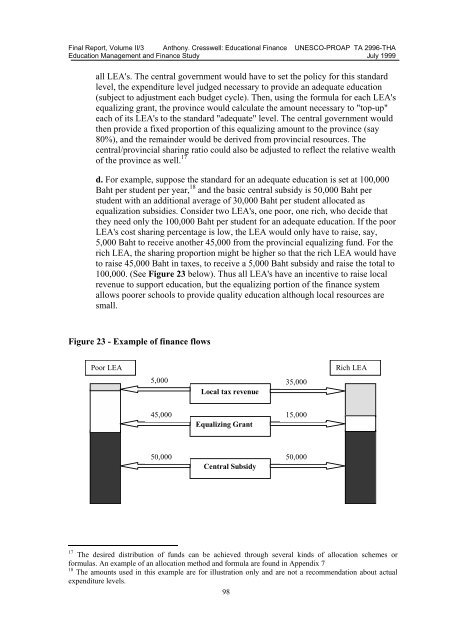Educational Finance in Thailand - UNESCO Bangkok
Educational Finance in Thailand - UNESCO Bangkok
Educational Finance in Thailand - UNESCO Bangkok
Create successful ePaper yourself
Turn your PDF publications into a flip-book with our unique Google optimized e-Paper software.
F<strong>in</strong>al Report, Volume II/3 Anthony. Cresswell: <strong>Educational</strong> <strong>F<strong>in</strong>ance</strong> <strong>UNESCO</strong>-PROAP TA 2996-THA<br />
Education Management and <strong>F<strong>in</strong>ance</strong> Study July 1999<br />
all LEA's. The central government would have to set the policy for this standard<br />
level, the expenditure level judged necessary to provide an adequate education<br />
(subject to adjustment each budget cycle). Then, us<strong>in</strong>g the formula for each LEA's<br />
equaliz<strong>in</strong>g grant, the prov<strong>in</strong>ce would calculate the amount necessary to "top-up"<br />
each of its LEA's to the standard "adequate" level. The central government would<br />
then provide a fixed proportion of this equaliz<strong>in</strong>g amount to the prov<strong>in</strong>ce (say<br />
80%), and the rema<strong>in</strong>der would be derived from prov<strong>in</strong>cial resources. The<br />
central/prov<strong>in</strong>cial shar<strong>in</strong>g ratio could also be adjusted to reflect the relative wealth<br />
of the prov<strong>in</strong>ce as well. 17<br />
d. For example, suppose the standard for an adequate education is set at 100,000<br />
Baht per student per year, 18 and the basic central subsidy is 50,000 Baht per<br />
student with an additional average of 30,000 Baht per student allocated as<br />
equalization subsidies. Consider two LEA's, one poor, one rich, who decide that<br />
they need only the 100,000 Baht per student for an adequate education. If the poor<br />
LEA's cost shar<strong>in</strong>g percentage is low, the LEA would only have to raise, say,<br />
5,000 Baht to receive another 45,000 from the prov<strong>in</strong>cial equaliz<strong>in</strong>g fund. For the<br />
rich LEA, the shar<strong>in</strong>g proportion might be higher so that the rich LEA would have<br />
to raise 45,000 Baht <strong>in</strong> taxes, to receive a 5,000 Baht subsidy and raise the total to<br />
100,000. (See Figure 23 below). Thus all LEA's have an <strong>in</strong>centive to raise local<br />
revenue to support education, but the equaliz<strong>in</strong>g portion of the f<strong>in</strong>ance system<br />
allows poorer schools to provide quality education although local resources are<br />
small.<br />
Figure 23 - Example of f<strong>in</strong>ance flows<br />
Poor LEA<br />
5,000<br />
Local tax revenue<br />
35,000<br />
Rich LEA<br />
45,000<br />
Equaliz<strong>in</strong>g Grant<br />
15,000<br />
50,000 50,000<br />
Central Subsidy<br />
17 The desired distribution of funds can be achieved through several k<strong>in</strong>ds of allocation schemes or<br />
formulas. An example of an allocation method and formula are found <strong>in</strong> Appendix 7<br />
18 The amounts used <strong>in</strong> this example are for illustration only and are not a recommendation about actual<br />
expenditure levels.<br />
98

















